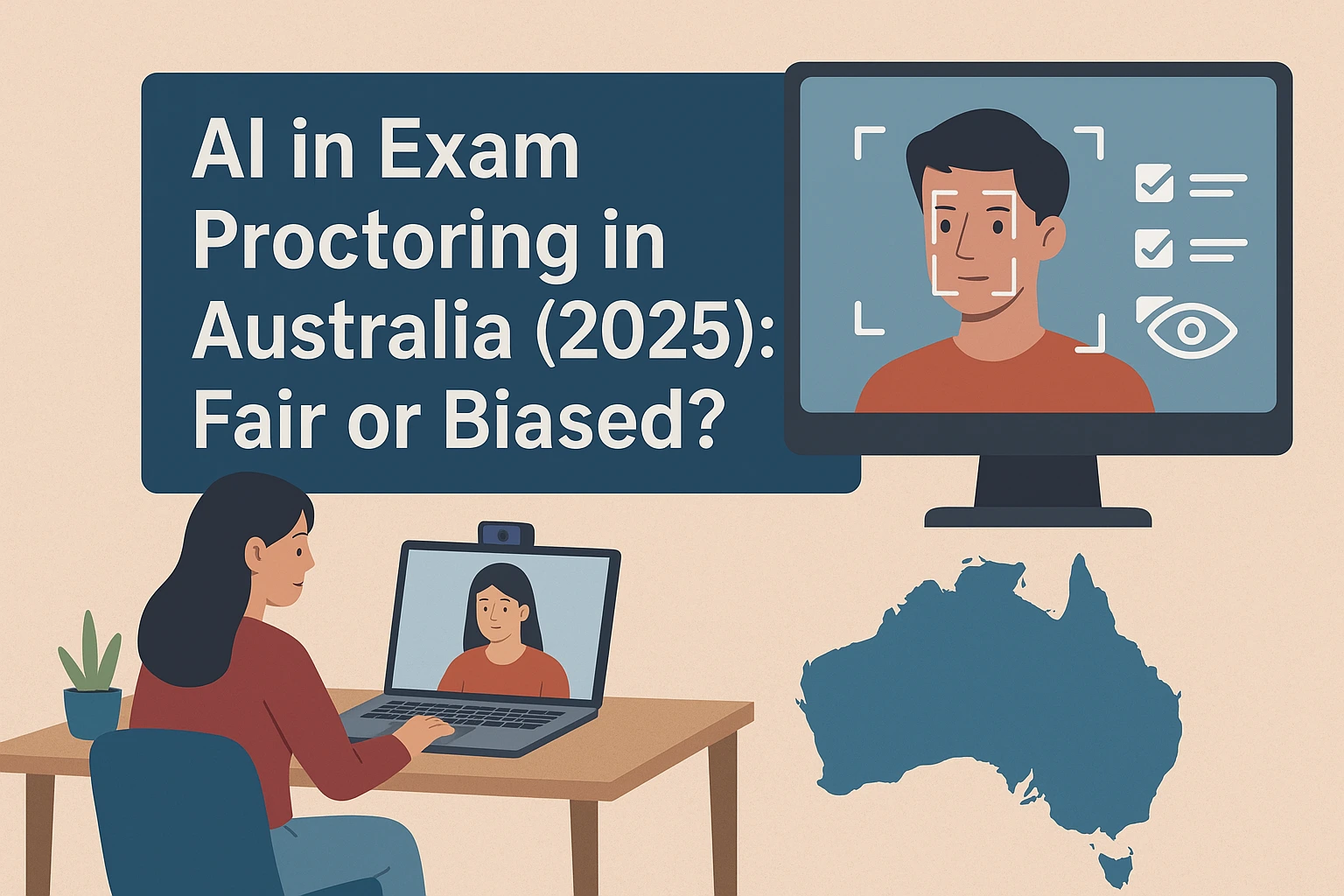AI in Exam Proctoring in Australia (2025): Fair or Biased? Evidence & Solutions

AI in exam proctoring tools are software that uses webcams, screen capture, and machine learning to detect cheating. These tools are now widely used by Australian universities. They promise scale and convenience, but raise real questions about fairness, privacy and accuracy. This article reviews the latest 2023–2025 evidence on bias and false positives, explains the Australian legal and regulatory context (OAIC, TEQSA), surveys vendor risks, and gives practical solutions universities and students can adopt to reduce harm.
What is AI in Exam Proctoring and How Does it Work?
AI exam proctoring (also called automated or remote proctoring) typically combines three elements: identity verification, live or recorded webcam video, and algorithmic analysis of activity during the exam (eye movement, face position, background noises, and on-screen events). Some systems add a lockdown browser that prevents switching windows or copying text. Vendors label suspicious events (e.g., “multiple faces detected”, “eye gaze off-screen”) and either notify a human reviewer or automatically penalise/flag the attempt. These tools are used when in-person supervision is impractical for distance learners, hybrid courses, or high-volume assessments.
Does AI Proctoring Produce Bias? Evidence & Known Failure Modes
Short answer: yes. Risks of biased outcomes and false positives are documented. Systematic reviews and recent studies show multiple failure modes:
- Facial-recognition and biometric errors: Algorithms trained on limited or non-representative datasets can misidentify or perform worse for some skin tones, ages, or facial features. When identity checks or behaviour models are inaccurate for particular groups, those students face higher odds of being flagged.
- Contextual false positives: Poor lighting, modest webcams, assistive devices, non-English accents, religious dress, or crowded living conditions can trigger flags that have nothing to do with cheating. Research and user reports show many false positives stem from environmental or accessibility issues, not misconduct.
- Lack of transparency and datasets: Many vendors treat detection models as proprietary, so independent audits are rare. That limits public understanding of true false positive rates and how performance varies across demographic groups.
The practical effect in Australia: students already face anxiety and reputational risk when flagged. Several universities have fielded complaints and media scrutiny since 2020, and public debates about fairness continue into 2025.
Privacy, Data & Legal Context in Australia
Australia’s privacy regulator, the Office of the Australian Information Commissioner (OAIC), has published guidance on the use of commercially available AI and makes clear that the Privacy Act applies when personal information is processed by AI systems. Institutions that use proctoring and study tools must meet privacy obligations: they should be transparent about what data is collected, minimise data held, get valid consent, and perform risk assessments on vendors and systems. The OAIC’s AI-focused guidance (Oct 2024) signals increasing regulatory scrutiny for any organisation using biometric or AI-driven products.
TEQSA, Australia’s higher education regulator, expects providers to safeguard academic integrity while respecting fairness and accessibility. TEQSA’s guidance notes on academic integrity and online assessment stress that assessment processes must be lawful, equitable and defensible, expect TEQSA to expect rigorous policy and oversight when automated tools are used.
Key legal takeaways for institutions in Australia:
- Treat biometric and webcam data as sensitive, minimise retention and explain purpose.
- Publish clear consent and appeal processes for students.
- Do privacy impact assessments and vendor audits before procurement.
- Document decisions about when proctoring is necessary and when alternatives are provided.
Who is Affected? Students, Universities and Disadvantaged Groups

AI in exam proctoring affects multiple groups differently:
- Students in disadvantaged or crowded living conditions are more likely to trigger false flags because of background noise or other household members.
- Students of colour and some gender/age groups can be disproportionately affected by biometric errors if the technology was not validated on diverse populations.
- Students with disabilities. For example those who need to look away or use assistive devices may be misinterpreted as suspicious behaviour unless accommodations are explicitly planned.
- Universities and staff face operational burdens: managing appeals, protecting data, and balancing assessment integrity with inclusion.
Universities must craft policies that protect students’ rights, provide alternatives, and ensure any flagged incidents get human review before penalties are applied.
Vendor Landscape and How Exam Events are Flagged
Major vendors mentioned in Australian media and university contracts include Proctorio, Respondus, ProctorU/Examity and Honorlock. Each vendor uses different mixes of identity checks, behavioural analytics, and flagging thresholds. Vendor privacy policies (e.g., Proctorio) state that institutions control student data, but operational reality depends on contracts and data processing agreements. Past incidents like historical breaches of some proctoring platforms highlight the importance of secure procurement and due diligence. Always cite vendor documentation and local procurement records when making claims about features or data handling.
What the Research Says: Accuracy, Fairness and Gaps
Recent systematic and literature reviews (2023–2025) show mixed evidence: automated proctoring can catch some cheating patterns but struggles with generalisability and demonstrable fairness. The strongest academic recommendation is human-in-the-loop: use AI to assist reviewers, not to make final punitive decisions. Reviews also call for open datasets, independent audits, and clearer reporting of false positive/negative rates by vendors and institutions.
Practical Steps: Fair Design and Mitigations for Universities
Universities can adopt straightforward measures to reduce harms:
- Require human review for all flagged events before any academic penalty.
- Publish privacy notices and data retention policies and obtain informed consent that explains what will be recorded and why.
- Perform algorithmic impact and privacy impact assessments before deploying systems. These assessments should include demographic fairness checks and vendor security audits.
- Offer alternatives, in-person exams, deferred assessments, or adjusted assessments for students with accessibility needs.
- Track and publish performance metrics (aggregate false positive rates) so the institution can be held accountable.
These steps align with OAIC guidance and the higher education regulator’s expectation that assessment is fair and defensible.
For Students: How to Reduce False Flags and How to Appeal
If you’re a student sitting a proctored exam in Australia, follow these practical steps:
- Prepare your environment: clear background, good lighting, and a quiet room. Test webcam and audio beforehand.
- Document accessibility needs: if you have a disability or special circumstance, get approved accommodations in advance and have documentation ready.
- Save evidence: if you’re flagged, take screenshots, note the timestamp, and keep communication copies with your instructor.
- Follow local appeal routes: universities normally have academic misconduct processes and student grievance mechanisms; start there. If privacy or data misuse is suspected, OAIC guidance outlines how institutions should handle complaints.
Policy Recommendations & Roadmap (Short → Long Term)
Short-term (operational) actions:
- Make human review mandatory.
- Publish clear consent, retention and appeal policies.
- Offer alternatives to webcam proctoring.
Medium-term (policy & procurement):
- Require vendor transparency: documented model performance and demographic testing.
- Conduct algorithmic impact assessments and include these in procurement packs.
Long-term (regulatory and research):
- Fund independent audits and open benchmark datasets for proctoring tools.
- Encourage TEQSA and OAIC collaboration to publish sector-level expectations and minimum standards for AI-driven assessment tools.
Final Thoughts: Fair or Biased?
Evidence shows real bias and privacy risks exist with AI exam proctoring, but these harms are not inevitable. With transparent procurement, mandatory human review, strong privacy safeguards, and accessible alternatives for students, universities can greatly reduce unfair outcomes. The path forward is not to ban all automation, but to govern it: insist on vendor accountability, protect students’ rights, and design assessments that don’t rely solely on brittle automation.
FAQs
Are AI proctoring systems biased?
Yes. Studies and reports show some algorithms perform worse for certain demographic groups and can produce false positives triggered by environmental or accessibility-related factors. Human review reduces the risk of unfair penalties.
Do online proctoring tools violate privacy laws in Australia?
Not automatically, but institutions must comply with the Privacy Act. OAIC guidance requires transparency, lawful basis, data minimisation and vendor due diligence. Failure to meet these obligations could expose institutions to regulatory action.
Can students opt out of webcam proctoring in Australia?
Policies vary by university. Many institutions offer alternatives or accommodations, especially for documented accessibility needs. Students should check their provider’s policy and request reasonable adjustments early.
How accurate is facial recognition for proctoring?
Accuracy varies by model and dataset. Some demographic groups experience higher error rates; independent validation and diverse training data are essential to improve fairness.
How do I challenge a proctoring false positive?
Collect evidence (timestamps, screenshots), contact your unit coordinator and student services, use your university’s misconduct/appeals procedure, and if needed, raise privacy concerns referencing OAIC guidance.

Similar Posts
iMedia Online Retail Summit Gold Coast, Australia
TikTok Music Clash with Universal Music Group Forces Removal of Popular Songs
Experience international-standard home lifts at our Brisbane experience centre